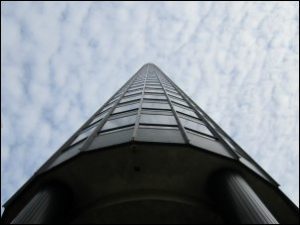Events Calendar
| S | M | T | W | T | F | S |
|---|---|---|---|---|---|---|
28 | 29 | 31 | 1 | |||
4 | 9 | |||||
13 | 14 | 15 | 16 | 17 | ||
18 | 19 | 20 | 21 | 22 | 23 | 24 |
25 | 26 | 27 | 28 | 29 | 30 | 31 |
by Jeff Hauser
Curtain walls are increasingly common in new hi-rise construction, although outside of downtown areas they’re still quite rare. So ours is a rather unique architectural aesthetic and, in addition to appearance, makes living here a bit different. This is the first of a few articles about curtain walls and will focus primarily on aspects of living here with ours.
The term, “curtain wall,” refers to our glass and metal exterior. The frame is literally hung from the concrete of our building – the opposite of neighboring buildings where each unit’s windows are set in concrete.
One of the benefits of our curtain wall is lower maintenance cost. It is a lot easier to get a good and long-lasting seal between glass and an aluminum frame than it is between window frames and a concrete facade!
While water can penetrate our curtain wall – more on that later – overall, we have less leakage than a conventional building. Also, metal facade wears better than masonry. That being said, however, moving parts are subject to wear; our operable windows are the biggest issue with regard to curtain wall maintenance.
Undeniably, weathering over the past 40+ years has dulled the appearance of the curtain wall. But it really is only appearance, the sunlight and oxidation having had no effect on the metal underneath. If we had a spare $6 million or so lying around, we could have the building repainted, perhaps in a different color, and it would look just as brilliant and amazing as the newer downtown construction.
Well, what about the noises the wall makes? Curtain walls are made of various metal parts that change size and shape depending on temperature. True, the changes are tiny, but they add up to a lot when spread across a building that is nearly 500 feet tall! The result is popping noises – sometimes quite loud, almost like a firecracker, as this huge frame expands and contracts. This issue happens with all curtain walls, and is just part of the experience of living with them, including fancy new construction downtown.
Our non-operable windows were resealed about six years ago. As a result of the excellent BASF product used, the seals are in great shape, adhering to the metal very well – so well, in fact, that we’ve been told we only need to inspect them every other year at this point.
Returning to those operable windows, you’ve noticed that they include rollable screens. Made of plastic, these screens over time become brittle and tear due to weather, sun-exposure, and frequent use. Typically, our maintenance crew replaces about 100 each year (which sounds like a lot until you realize this building has over 1700 operable windows.)
Our curtain wall isn’t like the outside of the space shuttle; air and water will penetrate under certain conditions, primarily the sections with openable windows. To mitigate that problem, each window has a “weep” system that captures and channels water penetrating the seal. When you see streams of water pouring down your window – but it doesn’t look like rain – that is the weep system working as designed.
(Understand, though, bets are off when, as in the past year, we’ve experienced heavy rain, ice and winds in excess of 70 mph for hours on end. Under these conditions, there is no way to prevent some water from penetrating the curtain wall.)
The “weep” system can also handle small amounts of water that may occur from inside our units – say, from leaks in the radiator/convector units that sit just inside the curtain wall.
Because of the way the curtain wall is hung, there is space between it and our concrete floors. When ice freezes and then melts on windows, say, a floor above, it can drip down along the inside of the curtain wall to floors below. Or that can occur from over-watering plants, and leaking plumbing fixtures.
Future issues of TowerTalk will go into the history of curtain walls, and how air flows and noise travels in buildings with curtain walls — also, of course, our summer spiders.
__________
More questions about curtain walls or other “All Things Mechanical” here at Park Tower? Send the to news@ptcondo.com, and we’ll try to address them.
the to news@ptcondo.com, and we’ll try to address them.